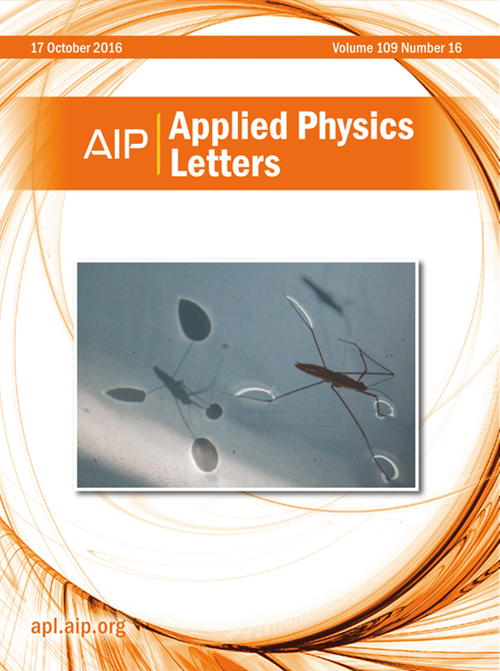Thermal transport and accommodation coefficient at the air–MoS2 interface
IF 3.5
2区 物理与天体物理
Q2 PHYSICS, APPLIED
引用次数: 0
Abstract
Heat conduction between air molecules and solid interfaces is substantial for thermal management in nanoelectronics devices. Such a process, governed by collisions between air molecules and the surface, is ascribed to the thermal accommodation coefficient (TAC). However, quantifying the TAC in miniaturized devices remains a significant challenge due to the limitation of measuring at small scales. Here, we characterized the heat conduction between air molecules and few-layer MoS2 at various temperatures using Raman spectroscopy, revealing several orders of magnitude higher values than bulk surfaces. The equivalent heat convection coefficient decreases from 9.35 × 104 to 7.09 × 104 W/m2K for temperatures ranging from 308 to 345 K. In addition, the TAC values are further determined based on the kinetic theory of air molecules, with the values decreasing from 0.88 to 0.71 as temperature increases. This is attributed to the increased kinetic energy mismatch between air molecules and the solid surface at higher temperatures. These findings deepen our understanding of heat conduction at the air–MoS2 interface and provide valuable insights for advancing thermal management strategies in nanoscale electronic devices.空气-二硫化钼界面处的热输运和容纳系数
空气分子和固体界面之间的热传导是纳米电子器件热管理的重要组成部分。这种由空气分子与表面的碰撞所控制的过程,被归因于热调节系数(TAC)。然而,由于在小尺度上测量的局限性,在小型化设备中量化TAC仍然是一个重大挑战。在这里,我们利用拉曼光谱表征了不同温度下空气分子和少层二硫化钼之间的热传导,揭示了比体表面高几个数量级的值。在308 ~ 345 K范围内,等效热对流系数从9.35 × 104减小到7.09 × 104 W/m2K。此外,根据空气分子的动力学理论进一步确定了TAC值,随着温度的升高,TAC值从0.88减小到0.71。这是由于在较高温度下空气分子和固体表面之间的动能不匹配增加。这些发现加深了我们对空气- mos2界面热传导的理解,并为推进纳米级电子器件的热管理策略提供了有价值的见解。
本文章由计算机程序翻译,如有差异,请以英文原文为准。
求助全文
约1分钟内获得全文
求助全文
来源期刊

Applied Physics Letters
物理-物理:应用
CiteScore
6.40
自引率
10.00%
发文量
1821
审稿时长
1.6 months
期刊介绍:
Applied Physics Letters (APL) features concise, up-to-date reports on significant new findings in applied physics. Emphasizing rapid dissemination of key data and new physical insights, APL offers prompt publication of new experimental and theoretical papers reporting applications of physics phenomena to all branches of science, engineering, and modern technology.
In addition to regular articles, the journal also publishes invited Fast Track, Perspectives, and in-depth Editorials which report on cutting-edge areas in applied physics.
APL Perspectives are forward-looking invited letters which highlight recent developments or discoveries. Emphasis is placed on very recent developments, potentially disruptive technologies, open questions and possible solutions. They also include a mini-roadmap detailing where the community should direct efforts in order for the phenomena to be viable for application and the challenges associated with meeting that performance threshold. Perspectives are characterized by personal viewpoints and opinions of recognized experts in the field.
Fast Track articles are invited original research articles that report results that are particularly novel and important or provide a significant advancement in an emerging field. Because of the urgency and scientific importance of the work, the peer review process is accelerated. If, during the review process, it becomes apparent that the paper does not meet the Fast Track criterion, it is returned to a normal track.
 求助内容:
求助内容: 应助结果提醒方式:
应助结果提醒方式:


